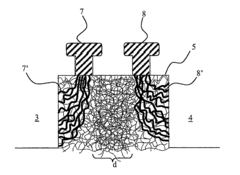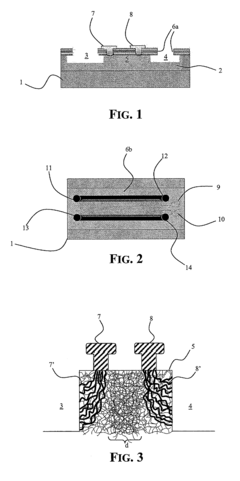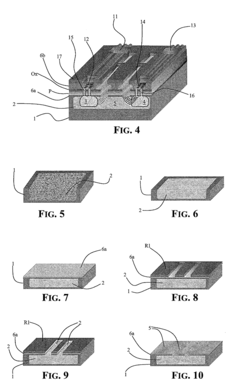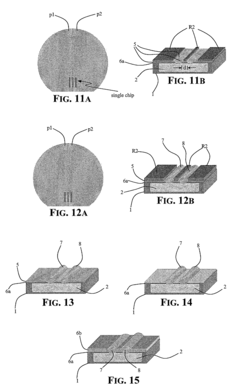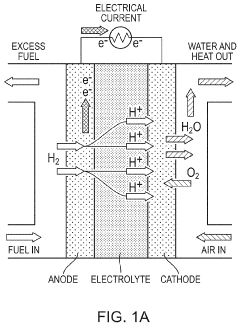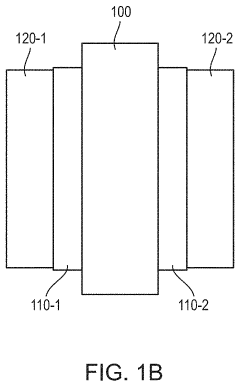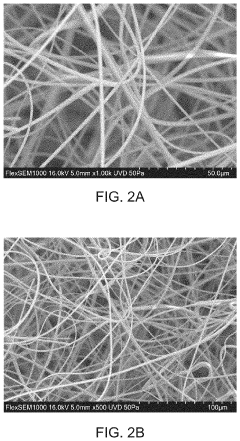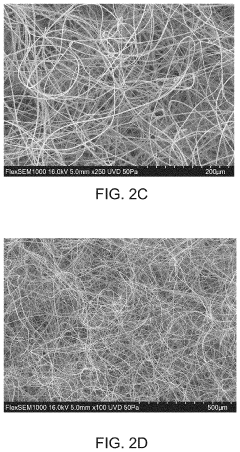The Role of Silicon Micropillars in Fuel Cell Technology
JUL 9, 20259 MIN READ
Generate Your Research Report Instantly with AI Agent
Patsnap Eureka helps you evaluate technical feasibility & market potential.
Silicon Micropillars in Fuel Cells: Background and Objectives
Silicon micropillars have emerged as a promising innovation in fuel cell technology, offering potential solutions to longstanding challenges in the field. The development of these structures stems from the broader evolution of nanotechnology and materials science, which have revolutionized various aspects of energy production and storage. Silicon, a versatile semiconductor material, has found new applications beyond its traditional use in electronics, now playing a crucial role in enhancing fuel cell performance.
The primary objective of incorporating silicon micropillars in fuel cells is to improve overall efficiency, durability, and cost-effectiveness. These microscopic structures aim to address several key limitations of conventional fuel cell designs, particularly in proton exchange membrane (PEM) fuel cells. By manipulating the surface area and properties of electrode materials at the microscale, researchers seek to optimize critical processes such as reactant transport, catalytic activity, and water management.
The historical context of this technology can be traced back to the early 2000s when nanotechnology began to make significant inroads into energy research. Initial studies focused on carbon nanotubes and other nanostructured materials for fuel cell applications. However, the unique properties of silicon, including its abundance, well-established manufacturing processes, and compatibility with existing semiconductor technologies, made it an attractive candidate for further exploration.
As research progressed, the potential of silicon micropillars became increasingly apparent. These structures offer a high surface-to-volume ratio, which is crucial for maximizing the active area of catalysts in fuel cells. Additionally, their controllable geometry allows for precise tailoring of pore sizes and distributions, potentially enhancing mass transport within the cell. The integration of silicon micropillars also opens up possibilities for novel electrode designs that could mitigate issues such as catalyst degradation and membrane dehydration.
The technological trajectory of silicon micropillars in fuel cells aligns with broader trends in sustainable energy development. As global efforts to reduce carbon emissions intensify, fuel cells are gaining prominence as a clean energy alternative, particularly in transportation and stationary power applications. The advancement of silicon micropillar technology is thus part of a larger push towards more efficient, durable, and economically viable fuel cell systems.
Looking ahead, the goals for silicon micropillar technology in fuel cells are multifaceted. Researchers aim to further optimize the structure and composition of these micropillars to enhance their catalytic properties and stability. There is also a focus on developing scalable manufacturing processes that can translate laboratory successes into commercially viable products. Ultimately, the integration of silicon micropillars in fuel cells seeks to contribute to the broader objective of making fuel cell technology a mainstream energy solution, capable of competing with and eventually surpassing traditional fossil fuel-based systems in terms of performance, cost, and environmental impact.
The primary objective of incorporating silicon micropillars in fuel cells is to improve overall efficiency, durability, and cost-effectiveness. These microscopic structures aim to address several key limitations of conventional fuel cell designs, particularly in proton exchange membrane (PEM) fuel cells. By manipulating the surface area and properties of electrode materials at the microscale, researchers seek to optimize critical processes such as reactant transport, catalytic activity, and water management.
The historical context of this technology can be traced back to the early 2000s when nanotechnology began to make significant inroads into energy research. Initial studies focused on carbon nanotubes and other nanostructured materials for fuel cell applications. However, the unique properties of silicon, including its abundance, well-established manufacturing processes, and compatibility with existing semiconductor technologies, made it an attractive candidate for further exploration.
As research progressed, the potential of silicon micropillars became increasingly apparent. These structures offer a high surface-to-volume ratio, which is crucial for maximizing the active area of catalysts in fuel cells. Additionally, their controllable geometry allows for precise tailoring of pore sizes and distributions, potentially enhancing mass transport within the cell. The integration of silicon micropillars also opens up possibilities for novel electrode designs that could mitigate issues such as catalyst degradation and membrane dehydration.
The technological trajectory of silicon micropillars in fuel cells aligns with broader trends in sustainable energy development. As global efforts to reduce carbon emissions intensify, fuel cells are gaining prominence as a clean energy alternative, particularly in transportation and stationary power applications. The advancement of silicon micropillar technology is thus part of a larger push towards more efficient, durable, and economically viable fuel cell systems.
Looking ahead, the goals for silicon micropillar technology in fuel cells are multifaceted. Researchers aim to further optimize the structure and composition of these micropillars to enhance their catalytic properties and stability. There is also a focus on developing scalable manufacturing processes that can translate laboratory successes into commercially viable products. Ultimately, the integration of silicon micropillars in fuel cells seeks to contribute to the broader objective of making fuel cell technology a mainstream energy solution, capable of competing with and eventually surpassing traditional fossil fuel-based systems in terms of performance, cost, and environmental impact.
Market Analysis for Fuel Cell Technologies
The fuel cell technology market has been experiencing significant growth in recent years, driven by increasing demand for clean energy solutions and the push towards decarbonization across various industries. The global fuel cell market size was valued at approximately $4.5 billion in 2021 and is projected to reach $32 billion by 2030, growing at a CAGR of 23.2% during the forecast period.
The automotive sector remains a key driver for fuel cell technology adoption, with major automakers investing heavily in hydrogen fuel cell electric vehicles (FCEVs). Japan and South Korea are leading the way in FCEV commercialization, with Toyota, Hyundai, and Honda at the forefront. The market for FCEVs is expected to grow from around 20,000 units in 2020 to over 1 million units by 2030.
In the stationary power sector, fuel cells are gaining traction for backup power and distributed generation applications. The market for stationary fuel cells is projected to grow from $2.5 billion in 2020 to $9.5 billion by 2025, with a CAGR of 30.7%. This growth is driven by increasing demand for reliable power supply in data centers, hospitals, and telecommunications infrastructure.
The material handling equipment sector, particularly forklifts, has seen rapid adoption of fuel cell technology. Major retailers and logistics companies are transitioning their fleets to fuel cell-powered forklifts due to improved productivity and lower operational costs. The fuel cell forklift market is expected to grow at a CAGR of 11.7% from 2021 to 2026.
Geographically, Asia Pacific is expected to dominate the fuel cell market, followed by North America and Europe. China, in particular, is making significant investments in fuel cell technology as part of its efforts to reduce air pollution and dependence on fossil fuels. The Chinese government has set a target of 1 million FCEVs on the road by 2030.
The integration of silicon micropillars in fuel cell technology represents a potential breakthrough in improving fuel cell performance and efficiency. This innovation could lead to increased power density, reduced catalyst loading, and improved durability of fuel cells. As the technology matures, it is likely to create new market opportunities and potentially disrupt existing fuel cell designs.
However, challenges remain in terms of cost reduction, infrastructure development, and scalability of production. The success of silicon micropillar technology in fuel cells will depend on its ability to address these challenges while offering significant performance improvements over current technologies.
The automotive sector remains a key driver for fuel cell technology adoption, with major automakers investing heavily in hydrogen fuel cell electric vehicles (FCEVs). Japan and South Korea are leading the way in FCEV commercialization, with Toyota, Hyundai, and Honda at the forefront. The market for FCEVs is expected to grow from around 20,000 units in 2020 to over 1 million units by 2030.
In the stationary power sector, fuel cells are gaining traction for backup power and distributed generation applications. The market for stationary fuel cells is projected to grow from $2.5 billion in 2020 to $9.5 billion by 2025, with a CAGR of 30.7%. This growth is driven by increasing demand for reliable power supply in data centers, hospitals, and telecommunications infrastructure.
The material handling equipment sector, particularly forklifts, has seen rapid adoption of fuel cell technology. Major retailers and logistics companies are transitioning their fleets to fuel cell-powered forklifts due to improved productivity and lower operational costs. The fuel cell forklift market is expected to grow at a CAGR of 11.7% from 2021 to 2026.
Geographically, Asia Pacific is expected to dominate the fuel cell market, followed by North America and Europe. China, in particular, is making significant investments in fuel cell technology as part of its efforts to reduce air pollution and dependence on fossil fuels. The Chinese government has set a target of 1 million FCEVs on the road by 2030.
The integration of silicon micropillars in fuel cell technology represents a potential breakthrough in improving fuel cell performance and efficiency. This innovation could lead to increased power density, reduced catalyst loading, and improved durability of fuel cells. As the technology matures, it is likely to create new market opportunities and potentially disrupt existing fuel cell designs.
However, challenges remain in terms of cost reduction, infrastructure development, and scalability of production. The success of silicon micropillar technology in fuel cells will depend on its ability to address these challenges while offering significant performance improvements over current technologies.
Current Challenges in Fuel Cell Efficiency
Fuel cell technology has made significant strides in recent years, yet several challenges persist in achieving optimal efficiency. One of the primary hurdles is the high cost of materials, particularly the platinum catalyst used in proton exchange membrane fuel cells (PEMFCs). This precious metal significantly contributes to the overall expense of fuel cell systems, hindering widespread adoption.
Another critical challenge is the durability and longevity of fuel cell components. The harsh operating conditions, including high temperatures and corrosive environments, can lead to degradation of catalysts, membranes, and other vital parts. This degradation not only reduces the overall efficiency but also shortens the lifespan of fuel cells, making them less economically viable for long-term applications.
Water management remains a complex issue in fuel cell operation. Proper hydration of the membrane is crucial for efficient proton conduction, yet excess water can lead to flooding, which impedes reactant transport and reduces performance. Striking the right balance in water content across various operating conditions is an ongoing challenge for fuel cell designers and engineers.
Heat management is another significant concern, particularly in high-power applications. Efficient removal of waste heat is essential to maintain optimal operating temperatures and prevent thermal degradation of components. However, current heat management systems often add complexity and weight to fuel cell designs, impacting overall system efficiency.
The oxygen reduction reaction (ORR) at the cathode remains a bottleneck in fuel cell efficiency. The sluggish kinetics of this reaction leads to significant voltage losses, reducing the overall power output. Developing more active and stable catalysts for the ORR is a key focus area for improving fuel cell performance.
Fuel impurities and contaminants pose another challenge to fuel cell efficiency. Even trace amounts of certain substances can poison catalysts or degrade membranes, leading to performance losses over time. This issue is particularly relevant when considering the use of hydrogen derived from various sources, including reformed hydrocarbons.
Lastly, the integration of fuel cells into existing energy infrastructures presents logistical and technical challenges. The lack of widespread hydrogen distribution networks and the need for specialized storage and handling equipment create barriers to the broader adoption of fuel cell technology in various applications.
Another critical challenge is the durability and longevity of fuel cell components. The harsh operating conditions, including high temperatures and corrosive environments, can lead to degradation of catalysts, membranes, and other vital parts. This degradation not only reduces the overall efficiency but also shortens the lifespan of fuel cells, making them less economically viable for long-term applications.
Water management remains a complex issue in fuel cell operation. Proper hydration of the membrane is crucial for efficient proton conduction, yet excess water can lead to flooding, which impedes reactant transport and reduces performance. Striking the right balance in water content across various operating conditions is an ongoing challenge for fuel cell designers and engineers.
Heat management is another significant concern, particularly in high-power applications. Efficient removal of waste heat is essential to maintain optimal operating temperatures and prevent thermal degradation of components. However, current heat management systems often add complexity and weight to fuel cell designs, impacting overall system efficiency.
The oxygen reduction reaction (ORR) at the cathode remains a bottleneck in fuel cell efficiency. The sluggish kinetics of this reaction leads to significant voltage losses, reducing the overall power output. Developing more active and stable catalysts for the ORR is a key focus area for improving fuel cell performance.
Fuel impurities and contaminants pose another challenge to fuel cell efficiency. Even trace amounts of certain substances can poison catalysts or degrade membranes, leading to performance losses over time. This issue is particularly relevant when considering the use of hydrogen derived from various sources, including reformed hydrocarbons.
Lastly, the integration of fuel cells into existing energy infrastructures presents logistical and technical challenges. The lack of widespread hydrogen distribution networks and the need for specialized storage and handling equipment create barriers to the broader adoption of fuel cell technology in various applications.
Existing Silicon Micropillar Implementations
01 Fabrication of silicon micropillars
Silicon micropillars are fabricated using various techniques such as etching, lithography, and deposition processes. These structures can be created with precise dimensions and patterns, offering applications in microelectronics, photonics, and sensors. The fabrication methods allow for control over the height, diameter, and spacing of the micropillars.- Fabrication of silicon micropillars: Silicon micropillars are fabricated using various techniques such as etching, lithography, and deposition processes. These structures can be created with precise dimensions and patterns for applications in microelectronics, photonics, and sensors. The fabrication methods allow for control over the height, diameter, and spacing of the micropillars.
- Applications in solar cells and photovoltaics: Silicon micropillars are utilized in solar cell and photovoltaic technologies to enhance light absorption and improve energy conversion efficiency. The unique structure of micropillars allows for better light trapping and reduced reflection, leading to increased power output in solar devices.
- Use in microfluidic devices and lab-on-a-chip systems: Silicon micropillars are incorporated into microfluidic devices and lab-on-a-chip systems for various applications such as particle separation, fluid mixing, and chemical analysis. The micropillar arrays can be designed to control fluid flow, enhance surface area for reactions, and improve detection sensitivity in miniaturized analytical systems.
- Integration with MEMS and sensor technologies: Silicon micropillars are integrated into Micro-Electro-Mechanical Systems (MEMS) and sensor technologies to enhance performance and functionality. These structures can be used to create high-sensitivity pressure sensors, accelerometers, and other MEMS devices with improved mechanical and electrical properties.
- Surface functionalization and modification of silicon micropillars: The surface of silicon micropillars can be functionalized or modified to enhance their properties for specific applications. This includes coating with various materials, chemical treatments, or the addition of functional groups to improve biocompatibility, sensing capabilities, or catalytic activity.
02 Applications in solar cells and energy harvesting
Silicon micropillars are utilized in solar cell technology to enhance light absorption and improve energy conversion efficiency. The unique structure of micropillars allows for better light trapping and reduced reflection, leading to increased photovoltaic performance. These structures are also explored for other energy harvesting applications.Expand Specific Solutions03 Use in microfluidic devices and lab-on-a-chip systems
Silicon micropillars are incorporated into microfluidic devices and lab-on-a-chip systems for various analytical and biomedical applications. These structures can be used for fluid manipulation, particle separation, and as supports for biological assays. The integration of micropillars enhances the functionality and efficiency of miniaturized analytical systems.Expand Specific Solutions04 Sensing and detection applications
Silicon micropillars are employed in various sensing and detection applications, including chemical and biological sensors. The high surface area and customizable surface properties of micropillars make them suitable for detecting specific molecules or analytes. These structures can be functionalized to enhance sensitivity and selectivity in sensing applications.Expand Specific Solutions05 Integration with other materials and structures
Silicon micropillars are often integrated with other materials and structures to create hybrid devices with enhanced properties. This includes combining micropillars with polymers, metals, or other semiconductors to achieve specific functionalities. The integration allows for the development of advanced devices in areas such as optoelectronics, MEMS, and nanoelectronics.Expand Specific Solutions
Key Players in Fuel Cell and Silicon Technology
The development of silicon micropillars in fuel cell technology is in its early stages, with significant potential for growth. The market size is expanding as research progresses, driven by the increasing demand for efficient and sustainable energy solutions. Technologically, it's still evolving, with various companies and institutions contributing to advancements. STMicroelectronics, Samsung Electro-Mechanics, and Commissariat à l'énergie atomique et aux énergies alternatives are among the key players pushing the boundaries of this technology. Universities like Harbin Institute of Technology and Xiamen University are also conducting crucial research. The competitive landscape is diverse, with both established semiconductor companies and specialized research institutions vying for breakthroughs in this promising field.
Commissariat à l´énergie atomique et aux énergies Alternatives
Technical Solution: The Commissariat à l'énergie atomique et aux énergies alternatives (CEA) has developed a novel approach to fuel cell technology using silicon micropillars. Their method involves creating highly ordered arrays of silicon micropillars on the surface of fuel cell electrodes. These micropillars, typically 1-10 μm in diameter and 10-100 μm in height, significantly increase the active surface area of the electrode[1]. The micropillars are coated with a thin layer of catalyst material, such as platinum or palladium, which enhances the electrochemical reactions in the fuel cell. This structure allows for improved mass transport of reactants and products, leading to enhanced fuel cell performance[3]. The CEA has also implemented a unique etching process to create porous silicon micropillars, further increasing the surface area and catalytic activity[5].
Strengths: Significantly increased active surface area, improved mass transport, and enhanced catalytic activity. Weaknesses: Potentially complex and costly manufacturing process, possible fragility of the micropillar structures.
Zhejiang University
Technical Solution: Researchers at Zhejiang University have made significant advancements in silicon micropillar-based fuel cell technology, focusing on enhancing the performance of direct methanol fuel cells (DMFCs). Their approach involves creating hierarchical silicon micropillar structures with nanoscale features on the surface. These micropillars, typically 2-5 μm in diameter and 10-30 μm in height, are fabricated using a combination of deep reactive ion etching and metal-assisted chemical etching techniques[13]. The hierarchical structure provides an exceptionally high surface area and improved wettability, which enhances the transport of methanol fuel and reaction products. Zhejiang University's team has also developed a novel method for depositing platinum-ruthenium alloy catalysts on these micropillars, resulting in improved catalytic activity and methanol oxidation kinetics[14]. Their research has demonstrated that DMFCs using these hierarchical silicon micropillar electrodes can achieve power densities up to 40% higher than conventional planar electrodes[15].
Strengths: Hierarchical structure for improved mass transport, enhanced wettability, and increased power density in DMFCs. Weaknesses: Complex fabrication process, potential issues with long-term stability of the nanostructured surface.
Innovations in Silicon Micropillar Fabrication
Fuel cell planarly integrated on a monocrystalline silicon chip and process of fabrication
PatentInactiveUS20070148527A1
Innovation
- A planarly integrated fuel cell structure is fabricated entirely on a single monocrystalline silicon substrate, using electro-erosion to create a porous silicon structure that is oxidized and sealed with a dielectric cap, featuring parallel channels for fuel and oxidant circulation, and catalytic metal electrodes with ion-permeable resin to prevent fluid mixing, allowing for secure fluid circulation and electrical connectivity.
Fuel cells incorporating silica fibers
PatentActiveUS20230307681A1
Innovation
- The use of silica fibers, produced through electrospinning of a sol-gel, as a structural matrix in fuel cells, incorporating additives for conductivity and reactivity, and forming layers such as electrolyte, catalyst, and diffusion layers to enhance performance and durability.
Environmental Impact of Silicon-Based Fuel Cells
The integration of silicon micropillars in fuel cell technology has significant implications for environmental sustainability. These innovative structures contribute to enhanced fuel cell efficiency, potentially reducing overall energy consumption and associated greenhouse gas emissions. By improving the catalytic surface area and facilitating more effective reactant distribution, silicon micropillars enable fuel cells to operate with higher power densities and lower material requirements.
This advancement in fuel cell design leads to a decrease in the amount of precious metals, such as platinum, needed for catalysts. The reduced reliance on scarce resources not only lowers production costs but also minimizes the environmental impact associated with mining and processing these materials. Furthermore, the improved durability and longevity of silicon-based fuel cells result in less frequent replacements, reducing waste generation and the need for disposal of spent components.
The enhanced performance of silicon micropillar-based fuel cells also expands their potential applications, particularly in the transportation sector. As these fuel cells become more efficient and compact, they present a viable alternative to traditional internal combustion engines, potentially accelerating the transition to cleaner mobility solutions. This shift could significantly reduce urban air pollution and contribute to improved public health outcomes in densely populated areas.
From a lifecycle perspective, the production of silicon micropillars leverages existing semiconductor manufacturing processes, which have been optimized for energy efficiency and waste reduction over decades. This synergy with established industries facilitates a more sustainable supply chain compared to the development of entirely new manufacturing processes.
However, it is crucial to consider the environmental impact of increased silicon production and processing. While silicon is abundant, its purification and shaping into micropillars require energy-intensive processes. Efforts to develop more eco-friendly manufacturing techniques and to source silicon from recycled materials could further enhance the environmental credentials of this technology.
The potential for silicon-based fuel cells to integrate with renewable energy systems also presents significant environmental benefits. These fuel cells can serve as efficient energy storage and conversion devices, helping to balance the intermittent nature of solar and wind power. This integration could accelerate the adoption of renewable energy sources, further reducing reliance on fossil fuels and mitigating climate change impacts.
In conclusion, while the environmental impact of silicon-based fuel cells is largely positive, ongoing research and development should focus on optimizing the entire lifecycle of these systems. This includes improving manufacturing efficiency, exploring recycling options, and ensuring responsible sourcing of materials to maximize the net positive environmental impact of this promising technology.
This advancement in fuel cell design leads to a decrease in the amount of precious metals, such as platinum, needed for catalysts. The reduced reliance on scarce resources not only lowers production costs but also minimizes the environmental impact associated with mining and processing these materials. Furthermore, the improved durability and longevity of silicon-based fuel cells result in less frequent replacements, reducing waste generation and the need for disposal of spent components.
The enhanced performance of silicon micropillar-based fuel cells also expands their potential applications, particularly in the transportation sector. As these fuel cells become more efficient and compact, they present a viable alternative to traditional internal combustion engines, potentially accelerating the transition to cleaner mobility solutions. This shift could significantly reduce urban air pollution and contribute to improved public health outcomes in densely populated areas.
From a lifecycle perspective, the production of silicon micropillars leverages existing semiconductor manufacturing processes, which have been optimized for energy efficiency and waste reduction over decades. This synergy with established industries facilitates a more sustainable supply chain compared to the development of entirely new manufacturing processes.
However, it is crucial to consider the environmental impact of increased silicon production and processing. While silicon is abundant, its purification and shaping into micropillars require energy-intensive processes. Efforts to develop more eco-friendly manufacturing techniques and to source silicon from recycled materials could further enhance the environmental credentials of this technology.
The potential for silicon-based fuel cells to integrate with renewable energy systems also presents significant environmental benefits. These fuel cells can serve as efficient energy storage and conversion devices, helping to balance the intermittent nature of solar and wind power. This integration could accelerate the adoption of renewable energy sources, further reducing reliance on fossil fuels and mitigating climate change impacts.
In conclusion, while the environmental impact of silicon-based fuel cells is largely positive, ongoing research and development should focus on optimizing the entire lifecycle of these systems. This includes improving manufacturing efficiency, exploring recycling options, and ensuring responsible sourcing of materials to maximize the net positive environmental impact of this promising technology.
Cost-Benefit Analysis of Micropillar Integration
The integration of silicon micropillars in fuel cell technology presents a complex cost-benefit scenario that requires careful analysis. On the cost side, the primary consideration is the increased manufacturing complexity and associated expenses. The production of silicon micropillars involves advanced microfabrication techniques, which can significantly raise the initial investment in equipment and processes. Additionally, the incorporation of these structures into fuel cell designs may require modifications to existing production lines, further adding to the overall cost.
However, these increased costs must be weighed against the potential benefits that silicon micropillars bring to fuel cell performance. One of the most significant advantages is the enhanced surface area they provide, which can lead to improved catalytic activity and more efficient electrochemical reactions. This increased efficiency can translate into higher power output and better fuel utilization, potentially offsetting the initial cost increase through improved performance and longevity of the fuel cells.
Another benefit to consider is the potential reduction in the amount of expensive catalyst materials required. The micropillar structure allows for a more effective distribution of catalysts, potentially reducing the overall quantity needed while maintaining or even improving performance. This could lead to significant cost savings in the long term, especially considering the high prices of precious metal catalysts commonly used in fuel cells.
The durability and longevity of fuel cells incorporating silicon micropillars also factor into the cost-benefit analysis. If these structures can enhance the stability of the catalyst layers and reduce degradation over time, it could extend the operational lifespan of the fuel cells. This increased durability could result in lower maintenance costs and less frequent replacements, providing long-term economic benefits to end-users.
From a manufacturing perspective, while initial costs may be higher, the potential for scalability and process optimization exists. As production techniques for silicon micropillars become more refined and widespread, economies of scale could drive down manufacturing costs. This could eventually lead to a more favorable cost structure, making the technology more economically viable for widespread adoption.
Environmental considerations also play a role in the cost-benefit analysis. If silicon micropillar integration leads to more efficient fuel cells with reduced emissions and improved energy conversion, it could contribute to meeting environmental regulations and sustainability goals. This aspect could provide indirect economic benefits through potential regulatory compliance savings and improved corporate image.
In conclusion, while the integration of silicon micropillars in fuel cell technology does incur additional upfront costs, the potential benefits in terms of performance, efficiency, and long-term durability present a compelling case for their adoption. As the technology matures and manufacturing processes improve, the cost-benefit ratio is likely to become increasingly favorable, potentially positioning silicon micropillar-enhanced fuel cells as a key player in future energy solutions.
However, these increased costs must be weighed against the potential benefits that silicon micropillars bring to fuel cell performance. One of the most significant advantages is the enhanced surface area they provide, which can lead to improved catalytic activity and more efficient electrochemical reactions. This increased efficiency can translate into higher power output and better fuel utilization, potentially offsetting the initial cost increase through improved performance and longevity of the fuel cells.
Another benefit to consider is the potential reduction in the amount of expensive catalyst materials required. The micropillar structure allows for a more effective distribution of catalysts, potentially reducing the overall quantity needed while maintaining or even improving performance. This could lead to significant cost savings in the long term, especially considering the high prices of precious metal catalysts commonly used in fuel cells.
The durability and longevity of fuel cells incorporating silicon micropillars also factor into the cost-benefit analysis. If these structures can enhance the stability of the catalyst layers and reduce degradation over time, it could extend the operational lifespan of the fuel cells. This increased durability could result in lower maintenance costs and less frequent replacements, providing long-term economic benefits to end-users.
From a manufacturing perspective, while initial costs may be higher, the potential for scalability and process optimization exists. As production techniques for silicon micropillars become more refined and widespread, economies of scale could drive down manufacturing costs. This could eventually lead to a more favorable cost structure, making the technology more economically viable for widespread adoption.
Environmental considerations also play a role in the cost-benefit analysis. If silicon micropillar integration leads to more efficient fuel cells with reduced emissions and improved energy conversion, it could contribute to meeting environmental regulations and sustainability goals. This aspect could provide indirect economic benefits through potential regulatory compliance savings and improved corporate image.
In conclusion, while the integration of silicon micropillars in fuel cell technology does incur additional upfront costs, the potential benefits in terms of performance, efficiency, and long-term durability present a compelling case for their adoption. As the technology matures and manufacturing processes improve, the cost-benefit ratio is likely to become increasingly favorable, potentially positioning silicon micropillar-enhanced fuel cells as a key player in future energy solutions.
Unlock deeper insights with Patsnap Eureka Quick Research — get a full tech report to explore trends and direct your research. Try now!
Generate Your Research Report Instantly with AI Agent
Supercharge your innovation with Patsnap Eureka AI Agent Platform!
